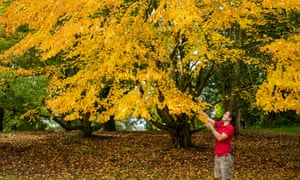The path above the pool garden at Knightshayes in Devon is one of the best vantage points on the estate to take in the colours.
As October marches on, the reds, yellows, purples and russets are beginning to deepen in hue and, when the clouds roll away, they gleam in the sunshine.
“It could be a really great autumn,” said the head gardener, Jess Evans, as she surveyed the scene at the National Trust property on the outskirts of Tiverton.
Good sunny spells in the spring and summer followed by bursts of rain in September means this could be a particularly fine autumn for colour.
It is good news for a growing band of UK “leaf peepers”, to borrow an American term, who are discovering pleasure and comfort in the turning of the seasons, especially at this most difficult of times.
“I think people are finding joy outdoors at the moment,” Evans said. “This last burst of colour feels all the more important this autumn.”

From the path above the pool, Evans pointed out the acers, which add vivid reds and orange to the scene, and the spindle bushes glowing an extraordinary pink.
She is also keen on the fruits that even from a distance contribute to the bright variety. The Golden Hornet crab apples are a lovely yellow and, happily for the visitor, linger as they are not favoured by birds. The Chinese or tea crab apples are tiny, translucent and glow bright red.
Evans is also a bark fan. The gentler, lower light means the subtle orange of the bark high on the trunk of the Scots pines is picked out more clearly.
And it is not just a visual treat. The toffee apple trees have rich yellow heart-shaped leaves with red veins running through them – but also give off a wonderful sweet smell. “We took the leaves indoors once to see if they’d still give off that scent but it vanished,” said Evans.
Simon Toomer, the National Trust’s national specialist for plant conservation, said he believed leaf peeping – or momijigari as it called in Japan – is becoming more of a staple in British life.
“I think it’s important not to lose touch with the seasons. You can be disappointed if you suddenly realise a season has passed by without you noticing,” he said.
During lockdown, the National Trust launched a hugely successful spring blossom watch. Toomer likened the spread of autumn in northern Europe to natural phenomena such as the wildebeest migration.
“This band of orange and red passes from the Arctic to the Mediterranean,” he said. “You can see it from space. It’s extraordinary.”
Gardens, parks and woods across the UK are reporting good colour – and strong visitor numbers.
Forestry England’s Westonbirt Arboretum in Gloucestershire enjoyed its busiest ever summer despite people having to pre-book and up to 100,000 visitors are expected this October.

Andrew Smith, Westonbirt director, said the creators of the gardens had made sure every autumn is spectacular. “I’ve been struck at the nuts and berries this year,” said Smith. Drifts of sea buckthorn at Westonbirt are dotted with iridescent orange berries while the red berries of the Japanese strawberry trees are also stunning.
The conkers are also abundant, prompting staff to organise an internal, socially-distanced conker competition.
Over in the Forest of Dean and the Wye Valley, tourist chiefs have produced a leaf-peeping guide. It promotes leaf-peeping breaks in woodland cottages and cabins and has designed a 50-mile leaf-peeping drive through the region, billed as the first of its kind in the UK.
In west London, Tony Kirkham, the head of the arboretum, gardens and horticultural services at the Royal Botanic Gardens, Kew, has been keeping a close eye on the American ash and hickories. The former, one of the first trees to turn, is already showing off lovely purple leaves while the latter is now a buttery yellow.
Two week ago, Kirkham felt the autumn colour would be nothing special. “It was dry and the trees were stressed. But there has been a lot of rain since then, which will help. If there is a little more sunshine followed by cold, but not freezing nights, and no big winds, the show could be one of the best.”